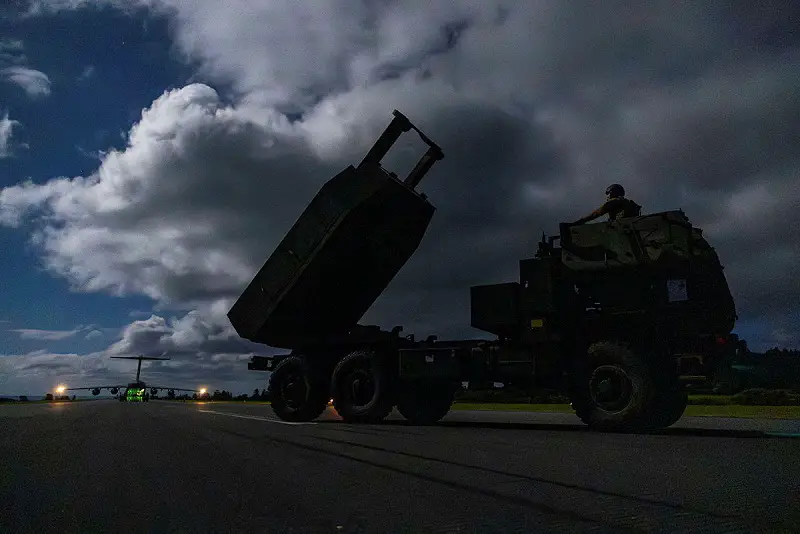The U.S. State Department has made a determination approving a possible Foreign Military Sale to the Government of Australia of M142 High Mobility Artillery Rocket Systems (HIMARS) and related equipment for an estimated cost of $975 million. The Government of Australia has requested to buy up to twenty-two (22) M142 High Mobility Artillery Rocket Systems (HIMARS); sixty (60) M30A1 Guided Multiple Launch Rocket System (GMLRS) Alternative Warhead (AW) Pods with Insensitive Munitions Propulsion System (IMPS); forty (40) M31A1 GMLRS Unitary (GMLRS-U) High Explosive (HE) Pods with IMPS; sixty-six (66) M30A2 Extended Range (ER)-GMLRS AW Pods; and twenty-four (24) ER GMLRS Unitary (HE) Pods. Also included are Reduced Range Practice Rocket (RRPR) Pods; intercom systems to support the HIMARS Launcher; M1084A2 HIMARS Re-Supply Vehicles (RSV); 9300-SL60TN Forklift; other related elements of program and logistic support.
The M142 HIMARS (M142 High Mobility Artillery Rocket System) is a light multiple rocket launcher developed in the late 1990s for the United States Army and mounted on a standard United States Army Family of Medium Tactical Vehicles (FMTV) truck frame. The launcher can be transported by Airbus A400M Atlas and Lockheed C-130 Hercules aircraft. The FMTV truck that transports the HIMARS was initially produced by BAE Systems Mobility & Protection Systems (formerly Armor Holdings Aerospace and Defense Group Tactical Vehicle Systems Division), the original equipment manufacturer of the FMTV. It was produced by the Oshkosh Corporation from 2010 to 2017. The HIMARS is similar in design to the M270 Multiple Launch Rocket System (MLRS), with the main exception being that it is a wheeled vehicle as opposed to a tracked vehicle. The HIMARS carries one ordnance pod, which is identical to the two pods used by the M270.

Guided Multiple Launch Rocket System (GMLRS) 227mm rockets have an extended range and add GPS-aided guidance to their Inertial Navigation System. GMLRS rockets were introduced in 2005 and the M30 and M31 rockets are, except for their warheads, identical. Each rocket pod contains 6 identical rockets. Both Lockheed Martin and the U.S. Army report that the GMLRS has a maximum range of 70+ km (43+ mi). M30A1 rockets with Alternative Warhead (AW). Range: 15–92 km (9.3–57.2 mi). GMLRS rocket that replaces the M30’s submunitions with approximately 182,000 pre-formed tungsten fragments for area effects without unexploded ordnance. Entered production in 2015. This warhead is superior not just because it does not use cluster munitions but is also superior to a normal high explosive round, a high explosive round is very impressive because it produces a big bomb and large pieces of shrapnel, but this round is small pellets and covers a much larger area.
M31A1 rockets with 200 lb (91 kg) high-explosive unitary warhead. Range: 15–92 km (9.3–57.2 mi). Improved M31 with new multi-mode fuze that added airburst to the M31’s fuze point detonation and delay. M30A2 rockets with Alternative Warhead (AW). Range: 15–92 km (9.3–57.2 mi). M31A2 rockets with 200 lb (91 kg) high-explosive unitary warhead. Range: 15–92 km (9.3–57.2 mi). Improved M31A1 with Insensitive Munition Propulsion System (IMPS). Only M31 variant in production since 2019. ER GMLRS rockets with extended range of up to 150 km (93 mi). Rockets use a slightly increased rocket motor size, a newly designed hull, and tail-driven guidance while still containing six per pod. It will come in unitary and AW variants. The first successful test flight of an ER GMLRS occurred in March 2021. Lockheed Martin anticipates adding the ER to its production line in the fiscal year 2023 contract award, and is planning to produce the new rockets at its Camden facility. Full operational capability is planned for 2025.
















